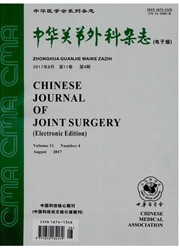

 中文摘要:
中文摘要:
目的观察钽棒联合富集骨髓干细胞治疗早期股骨头坏死临床疗效。方法选取2008年1月至2010年7月期间符合ARCO分期早期标准的患者共22例(35髋),ⅠB期6髋,ⅠC期10髋、ⅡA期4髋,ⅡB期7髋,ⅡC期7髋,ⅢA期1髋,采用骨髓血采集,骨髓干细胞富集,干细胞移植联合钽棒植入治疗。随诊观察患髋疼痛缓解程度,手术前后Harris评分和影像学进展情况。结果 19例(31髋)患者获2年以上(25~54个月,平均37个月)的随访。(1)髋关节功能行Harris评分:由术前(76.92±9.11)分升至术后(89.09±8.21)分,两组比较有统计学差异(t=7.160,P〈0.01);(2)髋关节影像学检查:术后继续塌陷ⅠC期1髋,ⅡB期1髋,ⅡC期1髋,最终行全髋关节置换,术后随访25个月的生存率为90.32%。MRI测得股骨头坏死表面积比,由术前的(31.89%±7.95%)降至术后的(11.20%±5.69%),两组比较有统计学差异(t=-11.494,P〈0.01)。结论钽棒联合富集骨髓干细胞治疗早期股骨头坏死近期疗效肯定,远期疗效有待进一步观察。
 英文摘要:
英文摘要:
Objective To discuss the effects of tantalum rod implant combined with enriched bone marrow stem cells (BMSCs) in treatment of moderate osteonecrosis of femoral head (ONFH). Methods 22 cases (35 hips) had been treated by tantalum rod implant combined enriched BMSCs from January 2008 to July 2010. According to Associatation Research Circulation Osseous (ARCO), six cases were stage Ⅰ B, ten cases were stage Ⅰ C, four cases were stage ⅡA, seven cases were stage ⅡB, seven cases were stage Ⅱ C, and one case was stage mA All patients were treated with tantalum rod implant combined enriched BMSCs. Clinical evaluation included: the pain relief, Harris hip score and the changes of radiograph. Results 19 cases (31 hips) were followed up for an average time of 37 months. The Harris score was (76. 92 ±9. 11 ) before surgery and it increased significantly to ( 89. 09 ±8.21 ) after surgery (t = 7. 160, P 〈 0. 01 ). One hip in stage Ⅰ C, one hip in stage Ⅱ B and one hip in stage ⅡC had aggravated to femoral head collapsing postoperatively; the survival rate was 90. 32% at the follow-up time of 25 months. The average ratio of necrotic articular surface area diminished significantly from (31.89%±7.95%, pre-operation) to (11.20% ± 5.69%, post-operation), (t = -11.494, P 〈 0.01). Conclusions Tantalum rod combined enriched BMSCs is an effective method to treat moderate ONFH, but the long-term effects need to be observed further.
 同期刊论文项目
同期刊论文项目
 同项目期刊论文
同项目期刊论文
 期刊信息
期刊信息
